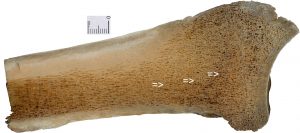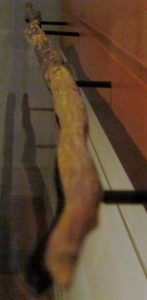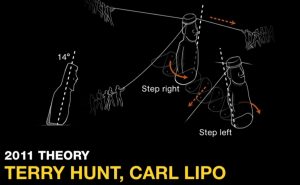It has long been understood that the Black Death was spread by flea-carrying rats. However, experts have begun to question how the disease could have spread as rapidly and had as devastating of an effect as it did (Current World Archaeology 2007). As a result, there has been increasing investigation into the environmental and social circumstances that created the conditions for such a disastrous plague.

Figure 1. An illustration of the mass burial at Lincolnshire showing the distribution of bodies, which notably includes many children. Image: University of Sheffield/PA
In 2016, a mass burial pit was discovered in Lincolnshire, England (Figure 1). Teeth recovered from the remains were used to detect DNA of Yersinia pestis, the plague-causing bacterium, which along with carbon dating confirmed that these were Black Death victims (Siddique 2016). Archaeologist Dr. Hugh Willmott explained that this rural community’s mass grave was indicative of how ill-prepared English society was to deal with such a calamity (Siddique 2016).
Discoveries of these mass graves have certainly improved the understanding of how 14th century England dealt with plague victims. But they have shed light on how people of the period lived, too. Archaeology has been used to establish the “epidemiological environment,” looking at housing, population density, and other factors to understand public health (Antoine 2008). This helps to reveal the conditions that would have allowed the disease to spread so rapidly.

Figure 2. Archaeologists from the Museum of London in the process of excavating a 14th century burial ground in Farringdon, England. Photograph: The Telegraph
In 2013, a mass burial site was discovered in Farringdon, England (Figure 2). Analysis of the site’s skeletons revealed much about the victims’ lives — many suffered from malnutrition and back problems, 16% had rickets, and two-thirds had grown up outside of London (Miller 2014). This helps paint a picture of 14th-century London as a city that attracted people from across Britain, in which many people lived difficult lives.
The study of plague victim remains can also reveal which groups were more likely to suffer from the disease. A study of over 600 bodies from one cemetery indicated that the elderly and those with pre-existing health conditions were more likely to succumb to the illness. One study in the Netherlands has even indicated that women were affected more frequently than men (DeWitte and Kowaleski 2017).
It is important to acknowledge the shortcomings of archaeological analysis of these burials. For example, certain areas of burial sites could contain more acidic soil, resulting in a loss of certain remains and altering the distribution of burials. Furthermore, many conditions, including the plague, do not affect bones (Antoine 2008). And when conditions do appear on the skeleton, their cause can be unclear. Bone lesions could indicate a weakened individual that succumbed to the plague, or a healthy individual who survived long enough for lesions to form due to the disease (DeWitte and Kowaleski 2017).
As it stands, archaeology has been unable to fully explain the circumstances leading to and resulting from the Black Death. When taken with a grain of salt, however, these findings can be employed to better understand those conditions, as well as the lives and experiences of the 14th-century English.
References
Antoine, Daniel. 2008 The Archaeology of “Plague”. Medical History. (27):101–114. PMID:18575084, accessed October 5, 2019.
Current World Archaeology 2007 New Light on the Black Death. Current World Archaeology (magazine), March 4, 2007. https://www.world-archaeology.com/books/new-light-on-the-black-death/, accessed October 5, 2019
DeWitte, Sharon N. and Kowaleski, Maryanne. 2017 Black Death Bodies. Fragments. DOI:http://hdl.handle.net/2027/spo.9772151.0006.001, accessed October 5, 2019.
Miller, Ben 2014 Skeletons buried beneath square were malnourished London victims of Black Death. Culture24, April 2, 2014. https://www.culture24.org.uk/history-and-heritage/archaeology/art474883, accessed October 5, 2019
Siddique, Haroon. 2016 Black Death burial pit found at site of medieval abbey in Lincolnshire. The Guardian, November 29, 2016. https://www.theguardian.com/black-death-mass-burial-pit-skeletons, accessed October 5, 2019
Images
Figure 2. https://www.telegraph.co.uk/history/9931808/Plague-victims-unearthed-by-Crossrail-workers.html
See also
This article discusses the facts that have led some to doubt that rats were responsible for the spread of the Black Death, and possible alternate explanations. https://www.history.com/news/rats-black-death
This video provides additional information on the archaeological methods employed at the mass burial site discovered at Lincolnshire. https://youtu.be/R5bNnnR8lwk














